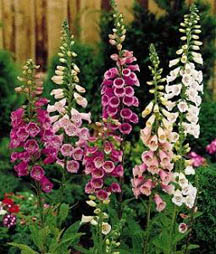Comments: Foxglove bloom in early summer with tall graceful spikes. Individual florets are thimble shaped with intricate inner markings. The most commonly known of the Foxgloves is Digitalis purpurea. It is very stately, reaching 3 to 4 feet and appreciates locations that provide some support against winds. Staking is helpful. All of the books and catalogs categorize the purpurea varieties as biennials but I know many (myself included) that have had the same plant for more than 3 years. At best though, they are a short lived perennial. If conditions are right, Foxglove will self sow quite readily. Look for the small downy seedlings.
There are some true perennial forms of Foxglove. Yellow Foxglove (Digitalis grandiflora) has shiny, rather than downy, leaves and is 2 to 2.5 feet tall. The individual flowers are large and yellow with brown markings. It is very hardy (zone 3).
Strawberry Foxglove (Digitalis mertonensis) is a cross between purpurea and grandiflora. It reaches 3 feet tall and has large coppery-pink flowers. It is hardy to zone 4 and will benefit from winter mulching.
Small Yellow Foxglove or Straw Foxglove (Digitalis lutea) also reaches 2 to 3 feet and is very hardy (zone 3). Individual flowers are smaller and are a pale yellow or cream color on arching stems. The appearance is very delicate and graceful. Like the common Foxglove, D. lutea will self sow quite freely.
All of the Foxgloves will do nicely in partial shade and enjoy a rich, moist (but not soggy) soil. They are well-suited for semi-shaded areas such as against a wooded area or along an east or north-facing wall. All flower in late spring or early summer. The perennial forms can be divided after flowering. New plants should be spaced about a foot apart. |


